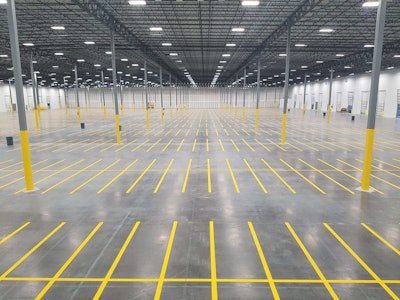
Striping warehouse floors wasn’t in Vish Munusami’s plans when he separated after five years in the military, including two tours in Iraq.
But last summer he found himself in an empty 250,000-sq.-ft. warehouse with a sealed concrete floor. He’d just won the bid to layout and stripe over 1,700 yellow stalls, which would ultimately require 39,000 linear feet of 4-in.-wide lines. He completed the job in 22 hours over two days – by far the largest job he’d ever done in his first year in the striping business.
In the army, Munusami had been a mechanic working on the Bradley Fighting Vehicle and had been a maintenance supervisor, but when he got out and came home to the United States, he wasn’t sure what he wanted to do.
“At that point in my life I felt a little stuck,” he says. “I had a pretty decent job as a maintenance manager, but I just wanted something more.”
A Franchise for Veterans
He started thinking about going into business for himself, so he investigated businesses with a low-cost barrier to entry, looked into franchises, and then into businesses that were veteran-focused. His research led him to G-Force Franchises for Veterans, the umbrella company for G-Force Parking Lot Striping, and the first franchise system to offer franchises exclusively to veterans.
“Being a veteran that struck me right away. It stood out with me,” he says.
He researched G-Force and talked with founder, Jack Child. Then he researched the pavement marking industry and the Tampa, FL, market to determine if there was a niche for another pavement marking contractor. He sought out local contractors and talked with them and determined there was room in the market for another striping business.
So last January Munusami and his wife, Melanie, became co-owners of G-Force Parking Lot Striping of Tampa, the first G-Force franchise. As an owner/operator he handles sales and the field work, while Melanie, who is still in the military, takes care of office tasks. G-Force Parking Lot Striping of Tampa generates revenue from new layout as well as re-stripe work. He’s also striped a seven-story parking garage.
“Basically, I saw an opportunity to get a start on my own and make some money and grow,” he says. “I’m pretty good at learning new things and anything with your hands I’m good at. Once I got familiar with the striping machine it all just fell into place.”
Child says G-Force Franchises for Veterans provides hands-on training for new franchise owners and has developed systems, procedures and even standardized equipment packages to make starting a striping business as easy as possible.
“We take as much responsibility for the day-to-day things business owners often overlook off their plate,” Child says. “We put as much of the business on autopilot as we can so they can focus on the day-to-day operation and customer service.”
Among the services G-Force provides to franchises are online pay-per-click campaigns, producing and managing marketing materials, search engine optimization, a customized quoting program and an email follow-up campaign once a prospect requests a quote.
“We take care of many tasks most owners don’t have time for and do that for them at a really high level. We give them all the tools to succeed and we provide extensive support. But at the end of the day it really falls on their shoulders. Their success will be based on the way they interact with the customers, how quickly they get the bids out, how they perform the work and how they follow up,” Child says.
“We don’t expect (or want) people to hire us simply because we’re veterans but because we are industry leaders and accountable. Just like in the military we wear our uniforms with pride, we show up on time, and we get the job done, and we are there for the customer if there’s a problem.”
Warehouse Striping Options
Munusami says the lead to stripe the 250,000-sq.-ft. warehouse came from the G-Force franchise group. He contacted the customer, provided an estimate and it was quickly approved.
“I gave the customer several options for the warehouse striping because with a concrete sealer the bond of traffic paint is not going to last that long,” he says.
Those options included:
- Use of a different paint, then applying a clear sealer on top of it. But the paint was more expensive, and the use of sealer was more costly, so the customer rejected the option.
- Grinding, etching, or scarifying the concrete surface where the lines were going to be painted, then applying paint over the prepared area. But on a job this big that process would have quadrupled the cost of the project.
The customer opted for the least-expensive option: applying a waterborne traffic paint on top of the concrete sealer.
Blueprints Don’t Match the Jobsite
On the first day Munusami arrived on site by 8:00 a.m. and after unloading his equipment and organizing his staging area he met with the customer and walked the warehouse.
“We went through the plans again to make sure I knew exactly what they wanted done. We worked from a blueprint the client provided,” Munusami says. He took his own measurements to make sure that what was on the blueprint was accurate – and it wasn’t.
“It was off by a few inches here and there,” Munusami says. “Once I realized that, I discussed it with the customer and explained the few inches that it was off. I explained why the space deviated from the blueprint and what we had to do to fix it.”
The blueprint called for laying out and striping 34 stalls in which the owner would place pallets, but Munusami’s measurements showed there was space only for 33 stalls. He revised the measurements and design to accommodate 33 stalls. What was the problem?
“The blueprint didn’t account for the 4-in. width of the striping itself. When you add those extra inches, you’re losing a lot of space over the entire warehouse.”
The customer approved the changes, and with the revised plan in hand, Munusami began work taking measurements with a tape measure to establish a baseline.
“For the baseline they had some good reference points to measure from,” he says. “There were large support beams, so we had measurements going off those beams in both directions. And we had a stopping point for the top, bottom and middle portion of the warehouse and those gave us some good starting points.”
He also used concrete expansion joints for starting and stopping points and to measure from. He said that throughout the entire job he chalked only two lines, snapping a chalk line in the middle aisles.
Striping Productivity Tips
Once Munusami got the measurements he went outside to his staging area to ready his machine and to get the laser ready to shoot long distances. Because he was going to stripe the entire job using the Graco auto-layout and the laser, he had to make sure calibration on the laser was as accurate as possible. He calibrated it out to 100 ft., which he says means it would be accurate to between 500 and 800 ft.
Then, with his striper in auto-layout mode, he walked from the baseline and measured out the stalls. The auto-layout system relies on a digital display where the operator can enter dimensions of the area to be striped and line intervals. Once the information is entered, an operator can walk the pavement and the striping machine will automatically spray dots on the pavement based on the information previously entered into the system. Munusami walked up and down the entire warehouse using his initial measurement, and all the while the machine was spraying a dot at the start and stop location of each stall (every 4 ft., 2 in.)
He also bought a 15-gal. paint hopper because he knew he was going to be putting down a significant amount of paint in a short time. “The 15-gal. hopper was a productivity decision,” he says. “I have one already that I use for white paint because most of my bigger jobs have been done with white paint. On this job it was clear it was going to be a lot more productive to dump three 5-gallon buckets into the hopper than to stop and change out the bucket every 5 gallons.”
He strained the paint into the hopper, set out the reflective “shadow boxes” needed at the end of each stripe for the laser, and he was ready to put paint on concrete and connect the dots.
On that first day Munusami completed a bit more than one-third of the warehouse floor striping. On the second day he finished the job, putting in total of 22 working hours. It was the biggest job he’d done so far, and only his second warehouse (the first required less than 30 gal. of paint). To protect himself from the noise he wore a head set with Bluetooth communication. Bay doors throughout were opened to create a crosswind for ventilation.
“This job was very straightforward because once you get some of the baseline measurements, you’re just striping a bunch of boxes,” he says. “The challenge was the size of the job; other than that, it was kind of easy.”
Munusami says the G-Force system, which includes use of the auto-layout striper and the self-propelled LineDriver attachment, enabled him to complete this job on his own.
“It greatly increased productivity because if someone has to go snap every line and every measurement, I think the layout itself might have taken two days,” he says. “Plus, it’s a lot nicer to sit down and paint than stand and do it. It increases productivity as well because I can move faster, and it saves wear and tear on the body.”
Growth of G-Force Franchises
Child says the franchisees’ customers respond to the veteran branding. “Either they’re veterans themselves or there’s a member in the family who’s in the service or who’s been in the service,” Child says. “As a veteran-owned and veteran-branded service we have an extra duty to our fellow veterans to represent veterans well and to provide the very best in service and quality the customer expects based on our brand.”
Child says G-Force now has 11 locations -- two in Florida, one serving New Hampshire and Massachusetts, one each in Alabama, Pennsylvania and Upstate New York, one in Atlanta, and four in Texas.
“That’s just since we started selling franchises in 2018,” Child says, adding that he expects to have 15 locations by the end of 2020 and 25 locations by the end of 2021. “Our goal is to have the largest geographic reach of any striping company in the country within the next 18 months.
“We’re very excited about where this is going,” Child says. “Once we hit around 15 locations that gives us a really big reach. We can then self-perform throughout large parts of the country.
“Also, if a G-Force franchisee gets a job that’s too big to handle, we can fly in people from other franchise locations to work with them. And the people we fly in will already be trained on the same machines, and in the same exact processes and systems. None of our franchisees ever has to say no because of the size of the job. We can just call in the cavalry, so to speak.”





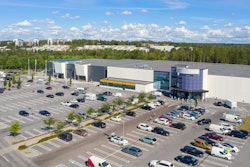
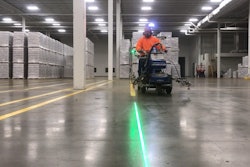
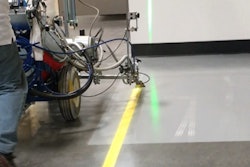
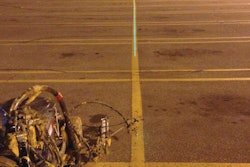


![Lee Boy Facility 2025 17 Use[16]](https://img.forconstructionpros.com/mindful/acbm/workspaces/default/uploads/2025/09/leeboy-facility-2025-17-use16.AbONDzEzbV.jpg?ar=16%3A9&auto=format%2Ccompress&fit=crop&h=135&q=70&w=240)








